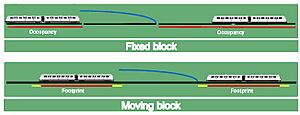Communications-based train control facts for kids
Communications-based train control (CBTC) is a super smart system that helps trains run safely and efficiently. It uses special radio signals to know exactly where every train is on the tracks. This means trains can run closer together without bumping into each other, making public transport faster and more reliable!
Contents
What is CBTC?
CBTC stands for Communications-based train control. It is a modern way to manage trains on a railway line. Think of it like a super-advanced traffic control system just for trains. Instead of old-fashioned signals, CBTC uses computers and radio waves to keep track of trains.
How Does CBTC Work?
CBTC systems use radio communication to talk between the trains and the equipment along the tracks.
- Knowing the exact spot: Each train constantly sends its exact location to a central computer. This computer knows where every train is at all times.
- Smart signals: Instead of fixed signals that tell a train to stop or go, CBTC creates a "moving block" around each train. This block is like a safety bubble that moves with the train.
- Safe distance: The system makes sure there's always a safe braking distance between trains. If one train slows down, the train behind it automatically adjusts its speed to maintain safety.
Old vs. New: Fixed Block vs. Moving Block
To understand why CBTC is so good, let's look at the old way versus the new way.
- Fixed Block (Old Way):
* Imagine a railway line divided into many fixed sections, like squares on a board game. * Only one train is allowed in each section at a time. * A train cannot enter a section until the train in front has completely left it. * This means trains have to keep a large, fixed distance apart, even if they could safely be closer. * This limits how many trains can run on a line in an hour.
- Moving Block (CBTC Way):
* With CBTC, there are no fixed sections. Each train has its own "safety bubble" that moves with it. * The system knows the exact position and speed of every train. * It calculates the minimum safe distance needed between trains in real-time. * This allows trains to run much closer together, safely. * This means more trains can use the tracks, reducing waiting times for passengers.
Benefits of CBTC
CBTC systems bring many advantages to modern railway networks:
- More Trains: Because trains can run closer together safely, more trains can operate on the same line. This helps reduce crowding and waiting times.
- Improved Safety: Knowing the exact position of every train at all times makes collisions much less likely. The system can react instantly to changes.
- Better Performance: Trains can run more smoothly and efficiently. This means fewer delays and a more reliable service for everyone.
- Energy Saving: The system can help trains brake and accelerate more efficiently, which can save energy.
Where is CBTC Used?
CBTC is used in many cities around the world, especially in busy metro systems. It helps these systems handle millions of passengers every day.
- The AirTrain at San Francisco International Airport was one of the first systems to use radio-based CBTC. It helps people move quickly between airport terminals.
Many new and upgraded railway lines are choosing CBTC because of its safety and efficiency benefits.
Images for kids
See also
 In Spanish: Sistema CBTC para niños
In Spanish: Sistema CBTC para niños





